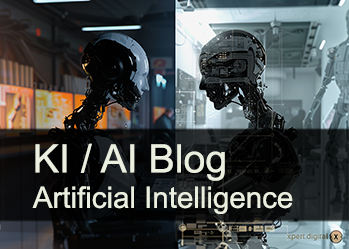Taking pessimism towards: India's demographic AI risk-chance or danger to the young generation?
Xpert pre-release
Language selection 📢
Published on: March 31, 2025 / update from: March 31, 2025 - Author: Konrad Wolfenstein

Taking pessimism towards: India's demographic AI risk-chance or danger to the young generation? - Image: Xpert.digital
India's demographic dividend in the age of artificial intelligence: a chance or a challenge?
A turning point for India's economy?
India stands on a crossroads of its economic development. For decades, the country's economic hope was based on its so -called demographic dividend - the competitive advantage, which results from a large, young and increasingly educated population. The common assumption was that the entry of a large number of young people would automatically lead to more jobs and significant economic growth. However, this optimistic view is now questioned in various industries by the rapid advance of artificial intelligence (AI).
A new, sobering analysis by the US investment bank Bernstein has questioned this thesis. The report argues that the rise of the AI could destroy the advantages that India expected from its young population. The main concern is that around 500 million Indians are expected to enter the labor market in the next two decades. In this development, the analysts of Bernstein see a possible “doom scenario” for a country that has geared its economic growth in a service -oriented model. They argue that AI systems are now able to do tasks more precisely and faster, often to a fraction of the costs associated with the employment of Indian engineers. This fundamental change requires a critical re -evaluation of the assumption that a larger young population automatically leads to more economic prosperity.
This article aims to examine the arguments of the amber analysis, to analyze the potential effects of AI on India's demographic dividend in the coming years, to examine counter arguments for this pessimistic view and to discuss the strategic imperative that India has to be taken into account in order to be found in this developing environment. By examining the double effects of AI on the labor market, comparison with other countries and taking into account the decisive role of education and qualification, this article should convey a comprehensive understanding of the challenges and opportunities that lie in front of India when it comes to the interface of its demographic potential and the rise of artificial intelligence.
Suitable for:
- Artificial intelligence shock for India: India's economic miracle in danger? AI threatens millions of jobs
India's demographic dividend: promise and potential
The demographic dividend refers to the economic growth potential, which can result from changes in the age structure of a population, especially if the proportion of the population of the employable age (typically between 15 and 64 years) is greater than the proportion of dependent population (children and older people). This transition takes place when a country goes through demographic changes that are typically characterized by falling birth and death rates, which leads to a larger proportion of the economically active population. India is currently in a phase in which its population is relatively young, with a lower proportion of dependent persons, which creates a significant opportunities for boosting economic growth.
India has a significant demographic advantage and has one of the youngest populations worldwide. The population of working age in India (15-64 years) is expected to achieve 67 % by 2030, which has the potential to significantly boost productivity and GDP growth and possibly increase per capita income. This large number of young people offer the promise of increased productivity, higher savings and investment rates and a large internal market to boost economic growth. From a historical point of view, there was considerable optimism that India's demographic dividend could lead the country to new economic heights, similar to the business wonders in East Asian countries, where a growing population of working age had a strong positive influence on economic growth.
However, the exploitation of the full potential of this demographic dividend is not without challenges. India has to struggle with existing problems, such as B. Significant qualification gaps in the employment population, a relatively low participation in employment, especially women, and a large informal sector that often lacks job security and adequate services. In addition, a considerable part of the Indian youth lacks professional knowledge, and there is a significant discrepancy between the skills of university graduates and the requirements of the labor market. Experts have long emphasized that significant investments in education, healthcare and competence development are essential in order to transform this demographic advantage into a productive and efficient working population. The unequal distribution of this demographic expansion across various states of India also represents an asymmetry, whereby the growth of the population of work in work will probably be concentrated on the poorest states. This regional disparity could lead to different effects of technological advances such as AI across the country.
The amber report: an impending danger to India's advantage?
The report of the analysts from Bernstein draws a worrying picture and characterizes the effects of AI on India's demographic dividend as a potential “doom scenario”.
The core argument of the amber analysis is that the rapid advance of the AI is a significant threat, since it may replace human labor in numerous sectors at a speed and costs that could destroy the advantages of India's large young people's work population. The report in particular emphasizes the economic profitability of AI subscriptions and indicates that these tasks could carry out a fraction of the costs associated with the employment of Indian engineers with greater precision and speed. This cost efficiency of AI questions the traditional workforce arbitrage advantage, which India has used in particular in its service-oriented growth model. The analysts of Bernstein require a “serious re -evaluation” of the long -term assumption that a larger influx of young people will automatically lead to more jobs and sustainable economic growth. Your assessment indicates that the sheer size of the Indian youth population is not a guarantee of economic prosperity in an era in which AI is increasingly able to fulfill a wide range of tasks, which may make a significant part of the future working population superfluous. While some more extensive research from Bernstein touches the development of AI in China compared to the West, the main focus of the report in question seems to be on the specific effects on India demographic dividend.
Suitable for:
The double effects of AI on the Indian labor market: displacement and creation
The integration of artificial intelligence into the Indian economy is expected to have twice the effect on the labor market, which will lead to the displacement of existing jobs as well as to create new roles and opportunities. Understanding these dynamics is crucial to anticipate the challenges and prepare for the future of work in India.
Several sectors in India are particularly susceptible to the loss of jobs due to automation and AI-controlled efficiency. The sectors information technology (IT) and Business Process Outsourcing (BPO), which were important employers in India, face increasing automation of tasks such as customer support and data entry. The processing trade, in particular roles that relate to routine and repetitive tasks on assembly ligaments, is also susceptible to automation through robotics and AI-based systems. In retail, KI is used for tasks such as inventory management, customer service chatbots and even automated health insurance processes, which has a potentially impact on jobs in traditional retail. The transport system could also suffer job losses due to the advent of autonomous vehicles and AI-optimized logistics. In addition, medium management and supervisory roles that contain routine decision-making and data analysis are also threatened by automation. Reports indicate potentially significant job losses, whereby Nasscom estimates that AI and automation could displace up to 69 million jobs in India by 2030, and the World Economic Forum predicts around 5.1 million job losses by 2025. Low earners who deal with repeating tasks are particularly susceptible to these changes. Even office workstations that contain data processing and compliance are increasingly automated.
However, the rise of AI also creates new jobs and possibilities in various sectors in India. There is a growing demand for experts with specialist knowledge in the areas of AI engineering, data science and machine learning. New roles such as AI trainers, ethical AI architects and AI consultants are created to support the development and use of AI technologies. Specialized roles that concentrate on natural language processing (NLP), computer vision and the integration of AI into existing systems are also increasing. The need for AI research and development is also growing, which results in opportunities for qualified researchers and scientists. Some forecasts indicate a considerable number of new jobs. A service report, for example, assumes that 2.73 million new technology-related jobs will be created in India by 2028, and Meity appreciates over 20 million new jobs due to digital interventions such as AI. These new roles often require special skills, which leads to a higher demand for AI-related specialist knowledge and potentially higher salaries in these areas.
India vs. the world: a comparative perspective on AI and demography
The integration of AI and its effects on the labor market is a global phenomenon, with different countries experiencing similar trends and challenges. Nations such as China and Singapore invest considerably in the AI infrastructure and development and position themselves as important actors in the global AI landscape. An analysis of the IMF indicates that almost 40 % of the global employment of AI are exposed to, whereby the effects in advanced and emerging countries are different. Advanced economies are faced with a higher exposure rate of around 60 %, while emerging countries such as India have a rate of around 40 %.
The comparison of the situation of India with other countries with similar demographic structures, such as: B. Large developing countries with an important youth population shows both parallels and differences. While the research excerpts do not provide detailed comparative analyzes with certain countries, the general trends indicate that the potential of the AI of disturbing traditional labor markets is a common concern. However, depending on factors such as the prevailing economic structure, the level of education and developing the competence of the employment population and the proactive measures of governments and industries, the specific effects will vary to adaptation to the changing technology landscape. China's rapid progress in the development of AI applications, especially in areas such as e-commerce and AI-supported recommendation systems, as Bernstein found,, for example, underline the potential of the AI to quickly change large economies with significant digital penetration.
India takes a unique position with its huge and young population, a rapidly growing digital infrastructure and a strong service -oriented economy. While the current distribution and adaptation of AI in India is relatively low in comparison to more developed economies in the USA, Europe and the developed Asia, this is both a challenge in relation to catching up and an opportunity to plan strategically for future effects. India's existing strength in the field of digital talents and its potential to become a global center for AI skills are significant advantages. The lower initial level of AI introduction could offer India a window to learn from the experiences of other nations and take targeted measures in order to alleviate potential negative consequences for its employment population and at the same time use AI for economic growth and development.
🎯🎯🎯 Benefit from Xpert.Digital's extensive, fivefold expertise in a comprehensive service package | R&D, XR, PR & SEM

AI & XR 3D Rendering Machine: Fivefold expertise from Xpert.Digital in a comprehensive service package, R&D XR, PR & SEM - Image: Xpert.Digital
Xpert.Digital has in-depth knowledge of various industries. This allows us to develop tailor-made strategies that are tailored precisely to the requirements and challenges of your specific market segment. By continually analyzing market trends and following industry developments, we can act with foresight and offer innovative solutions. Through the combination of experience and knowledge, we generate added value and give our customers a decisive competitive advantage.
More about it here:
Why AI does not have to be a threat to India's demographic dividend - maximize opportunities through AI adjustment
Counteract pessimism: alternative views of AI adaptation in India
While the amber report presents a potentially pessimistic outlook, alternative perspectives indicate that AI India's demographic dividend does not necessarily have to be completely destroyed. An important argument is that AI will complement human labor in many roles rather than replace them completely. This implies that some tasks can be automated, but human workers are still needed to work with AI systems and use their unique skills. It is also believed that those employees who learn effectively to use AI tools become more productive and valuable and possibly even replace those who cannot adapt to these technological advances.
Historically speaking, technological revolutions have led to the creation of completely new industries and professionals that were not predictable at the beginning. There is optimism that AI innovation and entrepreneurship in India could stimulate in a similar way and lead to the development of new business and employment opportunities that are currently unimaginable. In addition, India's young population can be equipped with strategic and sustainable investments in human capital and education with the skills and knowledge that are necessary to adapt to the changing requirements of a AI-controlled labor market and to be successful in this new environment. AI himself has the potential to revolutionize the education system, to enable personalized learning experiences and to make competence development more effective, which could better prepare the future employment population.
India has inherent strengths, including a considerable basis for digital talents, and has the potential to become a leading global center for AI skills and innovation. The Indian government has also shown a proactive approach by starting various initiatives that aim to promote AI research, development and digital infrastructure across the country. These efforts, combined with the adaptability and resistance, which are often observed in the Indian employment population, indicate that the negative predictions of the amber report are not inevitable and can be reduced by well-designed and effectively implemented strategies.
Strategic imperative: political and business reactions to the AI challenge
Coping with the potential challenges, which KI for India is demographic dividend, requires a concerted exertion, the government's proactive political measures and strategic reactions in the economic sector.
The Indian government has already initiated several programs that aim to promote AI competence and to develop the necessary skills in the employment population. Initiatives such as the Indiaai Mission, Futureskills Prime and Yuvai concentrate on building a AI-enabled work population through various competence structure and further education programs and integrating AI into academic curricula from school to the university. The government also works to set up competence centers in the areas of AI and data science in order to promote research and innovation in these critical areas.
Industry and the private sector also play a crucial role in coping with this transition. Increased investments in AI research and development by private companies are essential to promote innovations in India. In addition, companies must take responsibility for reorganizing their existing workforce in order to adapt to the changed requirements that arise from the introduction of AI. Cooperation between industry and educational institutions are essential to ensure that the training programs are geared towards the specific needs and requirements of the labor market.
In order to reduce the potential loss of jobs, the government may have to consider political interventions, such as: B. strengthening social security networks, the provision of unemployment benefit and the support programs for employees who lose their workplace through automation. There is also the possibility to check guidelines, encourage companies to concentrate on using AI to expand human abilities instead of exclusively targeting jobs. The idea of taxing companies that replace human workers with AI was also proposed as a potential measure if the private sector does not respond to the employment effects.
The promotion of a dynamic ecosystem for AI innovation and entrepreneurship is also of crucial importance. The support of AI startups through financing, mentoring and access to resources can promote the development of new AI-based solutions and create new jobs. Initiatives such as the proposed National AI Marketplace (Naim) could facilitate the exchange of data and use AI models and thus further boost innovations in various sectors.
Suitable for:
The central role of education and competence development in the age of the AI
A fundamental transformation of the Indian educational and competence development ecosystem is of the utmost importance for the country to effectively use its demographic dividend in view of the rapid AI progress. Incremental changes to the existing system will probably not be sufficient to manage the scope and speed of the technological upheavals by AI.
The integration of AI-focused curricula from the basic school levels to university education is essential to build up a future-proof working population. It must be emphasized for early vocational training in order to convey practical skills to the students that can enable more smooth transition from training to employment. The strengthening of partnerships between academic institutions and industries will ensure that the imparted skills are directly related to the requirements of the developing labor market. In addition, the potential of AI to personalize learning paths and improve general educational results should be used to create more effective and appealing learning experiences for students across the country.
The focus of the educational and competence development initiatives must go beyond the imparting of technical skills in the areas of AI, machine learning and data science. The development of unique human abilities such as critical thinking, complex solving solutions, creativity and adaptability will be just as important, since these are the skills that are probably highly valued in a AI-supported world. Continuous learning and further training During the entire career of an individual, it will also be crucial to ensure that the employment population remains relevant and competitive in a rapidly changing technology landscape.
Coping with the existing competence gap in the AI area requires a multi -track approach. India not only has to enlarge its entire AI talent pool, but also focus on promoting and keeping top-class AI research talents in order to promote innovations from their own country. Strategies to contain the talent migration and to improve the overall quality of the MINT formation are essential to ensure that a larger part of the graduates are able to work and has the advanced skills required in the AI age.
Long -term vision: Integration of AI for sustainable economic growth in India
With a view to the future, the integration of AI has an immense potential for promoting sustainable economic growth and development in India. Long -term economic advantages could include significant productivity increases, an innovation boost in various sectors and a significant increase in Indian GDP as a whole. Estimates indicate that AI could make a significant contribution to the Indian economy, with some forecasts predicting an increase of almost $ 957 billion by $ 2035. It is expected that key sectors such as agriculture, healthcare and processing businesses will experience transformative growth through the use of AI technologies.
In view of the long -term demographic changes, even beyond the next two decades, the integration of AI could play a crucial role. If India's population finally starts age, KI could help to deal with challenges in connection with a shrinking personnel population and an increasing addiction rate by increasing productivity and supporting an aging population.
However, the widespread introduction of AI also requires careful consideration of ethical and social implications. Questions such as data protection, the potential for algorithmic distortions that lead to unfair results, and the general need for a responsible AI development must be addressed proactively through appropriate regulations and ethical framework conditions. In addition, there is a risk of increasing inequality if the advantages of AI-driven economic growth are not distributed fairly across all parts of society.
Despite these challenges, India has the strong wish to establish itself as a global market leader in the field of AI, and its demographic dividend, if it is promoted and strategically brought into harmony with AI development, can be an important factor for the realization of this vision. By concentrating on building a qualified employment population, promoting a robust innovation ecosystem and consideration of ethical considerations, India can use the power of AI to achieve long -term sustainable and integrative economic growth.
Suitable for:
- New markets, new opportunities: India and Asia as a springboard for German SMEs – with B2B trading platforms and more
Design the future of the demographic dividend of India with AI
The analysis of the amber report and the broader landscape of the effects of AI on India shows a complex interplay between the demographic potential of the country and the transformative power of artificial intelligence. While the amber analysis raises authorized concerns regarding the potential of AI to undermine the traditional advantages of the large and young people of India, a more comprehensive perspective recognizes both the challenges and the important opportunities that lie ahead.
The duality of the AI with its ability both for the workplace and the creation of new jobs requires a balanced and strategic approach. Global comparisons show that India is not only struggling with these problems, and its relatively lower current degree of AI introduction could offer a valuable window for proactive planning and intervention. Counter arguments to a purely pessimistic point of view emphasize the historical tendency of technological progress, to create new opportunities, and to expand the potential of AI, human skills.
Ultimately, India's ability to successfully design the future of its demographic dividends in the Age of AI, the government, industry, industry and educational institutions depend on proactive and well -coordinated measures. Strategic imperatives include sustainable investments in extensive competence structure and further education programs, promoting a robust ecosystem for AI innovation and entrepreneurship as well as the implementation of political measures to contain potential job losses and to ensure a fair transition for the employment population. The central role of education cannot be emphasized enough; A fundamental transformation of the education system is essential to equip India's youth with the future-proof skills that are necessary to be successful in a AI-driven economy. By persecution of a long-term vision that prioritizes ethical considerations and integrative growth, India has the potential not only to reduce the risks that are emphasized in the amber report, but also to use the power of AI to achieve sustainable economic growth and to secure a prospering future for its emerging young population.
We are there for you - advice - planning - implementation - project management
☑️ SME support in strategy, consulting, planning and implementation
☑️ Creation or realignment of the digital strategy and digitalization
☑️ Expansion and optimization of international sales processes
☑️ Global & Digital B2B trading platforms
☑️ Pioneer Business Development
I would be happy to serve as your personal advisor.
You can contact me by filling out the contact form below or simply call me on +49 89 89 674 804 (Munich) .
I'm looking forward to our joint project.
Xpert.Digital - Konrad Wolfenstein
Xpert.Digital is a hub for industry with a focus on digitalization, mechanical engineering, logistics/intralogistics and photovoltaics.
With our 360° business development solution, we support well-known companies from new business to after sales.
Market intelligence, smarketing, marketing automation, content development, PR, mail campaigns, personalized social media and lead nurturing are part of our digital tools.
You can find out more at: www.xpert.digital - www.xpert.solar - www.xpert.plus



























